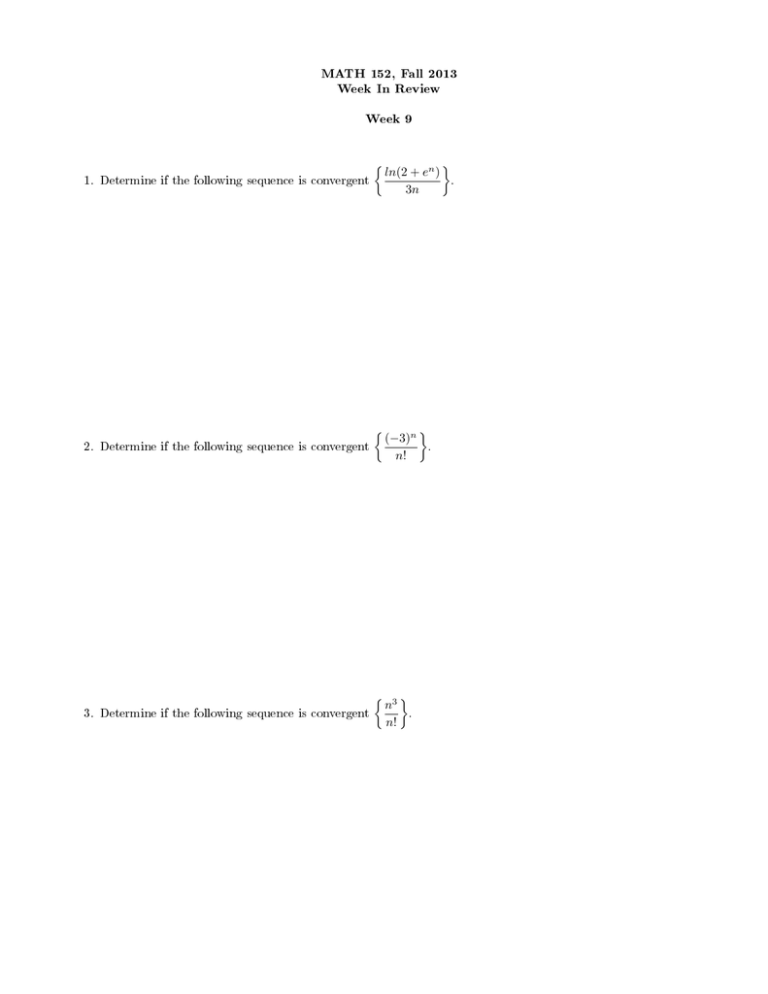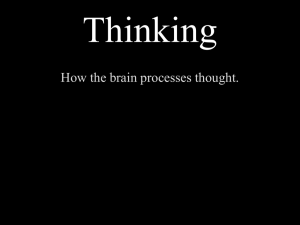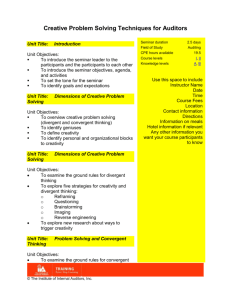MATH 152, Fall 2013 Week In Review Week 9 ln(2 + e
advertisement

MATH 152, Fall 2013
Week In Review
Week 9
1. Determine if the following sequence is convergent
ln(2 + en )
.
3n
2. Determine if the following sequence is convergent
(−3)n
.
n!
3. Determine if the following sequence is convergent
n3
.
n!
4. Determine if the following sequence is convergent
1·3·5·
1
5. Determine if the following sequence a1 = 1 an+1 =
1 + an
limit.
6. The Fibonacci sequence is dened by f1 = 1,
show an−1 = 1 +
1
an−2
f2 = 1,
· · · · (2n − 1)
.
(2n)n
f or
n≥1
fn = fn−1 + fn−2
. Assuming that an is convergent,nd its limit
is convergent. If so, the nd its
f or
n ≥ 3. Let an =
fn+1
and
fn
1
7. Show that the sequence a1 = 2 an+1 =
f or n ≥ 1, satises 0 < an ≤ 2 and is decreasing. Deduce
3 − an
that the sequence is convergent, and nd its limits.
1
f or n ≥ 1. Find the rst eight terms of the
8. A sequence is dened recursively by a1 = 1 an+1 = 1 +
1 + an
sequence. What do you notice about the odd terms and even terms ? By cinsidering the odd and even terms
separately, show that an is convergent and nd its limit .
∞ X
1
1
√ −√
.
9. Determine the sum of the series
n
n+1
n=1
10. Let an =
∞
X
2n
. Determine whether {an } is convergent. Determine whether
an is convergent.
3n + 1
n=1
11. Determine whether the series 4 +
32
8 16
+
+
+ · · · is convergent or divergent. If it is convergent, nd its sum.
5 25 125
∞ X
1
12. Determine whether the series
is convergent or divergent. If it is convergent, nd its sum.
e2n
n=1
13. Determine whether the series
∞
X
[2(0.1)n + (0.2)n ] is convergent or divergent. If it is convergent, nd its sum.
n=1
14. Determine whether the series
15. Determine whether the series
∞
X
n2
is convergent or divergent. If it is convergent, nd its sum.
3(n + 1)(n + 2)
n=1
∞
X
1
is convergent or divergent. If it is convergent, nd its sum.
n(n
+ 2)
n=1
16. Determine whether the series
17. Determine whether the series
∞
X
1
is convergent or divergent. If it is convergent, nd its sum.
2−1
4n
n=1
∞
X
n=1
18. Determine whether the series
∞
X
√
n
is convergent or divergent. If it is convergent, nd its sum.
1 + n2
1
is convergent or divergent. If it is convergent, nd its sum.
1
+
2−n
n=1
19. Find the values for x such that the series
∞
X
(x − 3)n is convergent. Find the sum for those values of x.
n=1
20. Find the values for x such that the series
21. Find the values for x such that the series
∞
X
1
is convergent. Find the sum for those values of x.
n
x
n=1
∞
X
n=1
tann x is convergent. Find the sum for those values of x.
∞
X
22. Find the sum of the series
1
.
(4n
−
1)(4n
− 3)
n=1
23. Find the sum of the series
∞
X
n2 + 3n + 1
.
(n2 + n)2
n=1
24. If the n − th partial sum of a series
∞
X
an is
n=1
sn =
nd an and
∞
X
n=1
an .
n−1
n+1
25. If the n − th partial sum of a series
∞
X
an is
n=1
sn = 3 − n2−n
nd an and
∞
X
an .
n=1
26. What is the value for c if
∞
X
(1 + c)−n .
n=1
27. Suppose that
∞
X
n=1
an
an 6= 0, is known to be convergent. Prove that
∞
X
1
is divergent.
a
n=1 n
28. Write out the partial fraction decomposition of the function
values of the coecients.
29. Write out the partial fraction decomposition of the function
numerical values of the coecients.
x4 + x2 + 1
. Do not determine the numerical
+ 1)(x2 + 4)2
(x2
(x −
19x
. Do not determine the
+ 5x + 3)2
1)3 (4x2
x3 + x2 + 1
30. Write out the partial fraction decomposition of the function 4
. Do not determine the numerical
x + x3 + 2x2
values of the coecients.
18 − 2x − 4x2
dx .
+ 4x2 + x − 6
31. Evaluate the integral
Z
32. Evaluate the integral
Z
x4
dx .
x4 − 1
33. Evaluate the integral
Z
x3 − 2x2 + x + 1
dx .
x4 + 5x2 + 4
x3
34. Evaluate the integral
Z
4
1
dx .
x2 + x − 6
2
1
dx .
x2 − 1
0
35. Evaluate the integral
Z
36. Evaluate the integral
Z
−2
0
∞
√
1
dx .
x(1 + x)
37. If the innite curve y = e−x ,
x ≥ 0, is rotated about the x − axis, nd the area of the resulting surface.
38. Find the area of the surface obtained by rotating the curve x = acos3 (θ), y = asin3 (θ),
x − axis.
0 ≤ θ ≤ π/2 about the
39. Set up the integral giving the surface area of the ellipsoid obtained by rotating the ellipse x = acos(θ), y =
bsin(θ), a ≥ b, about the y − axis.





